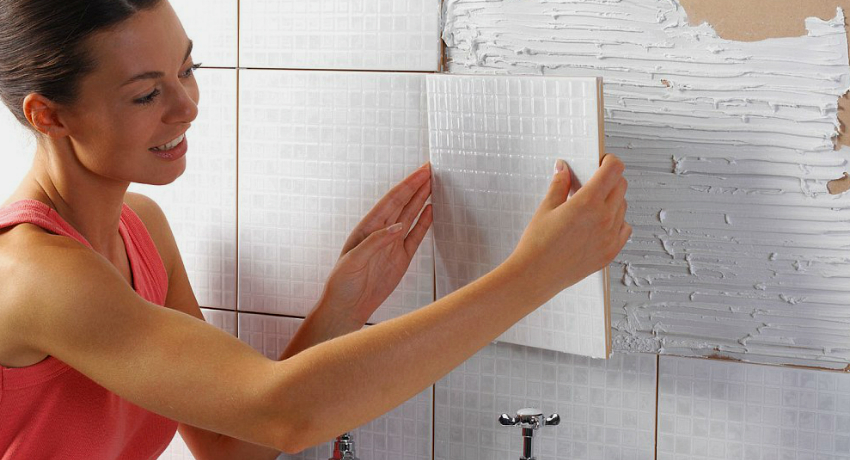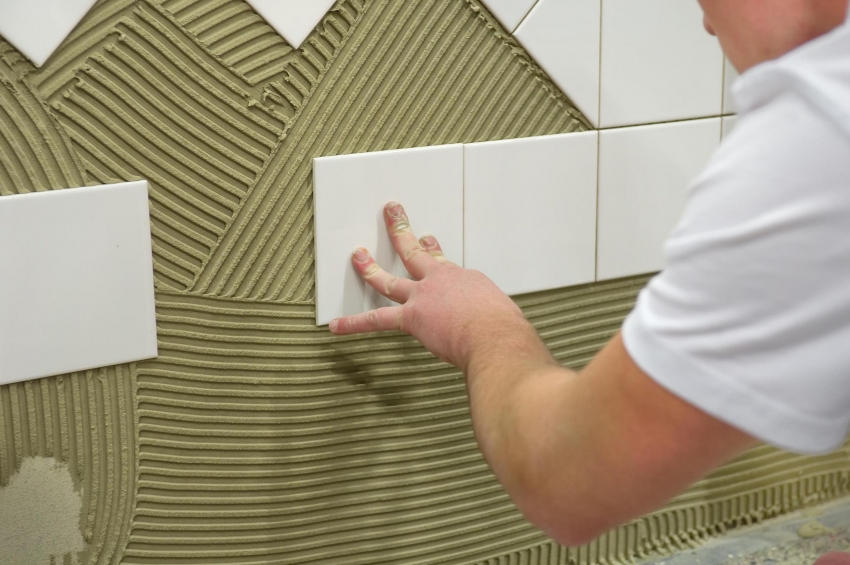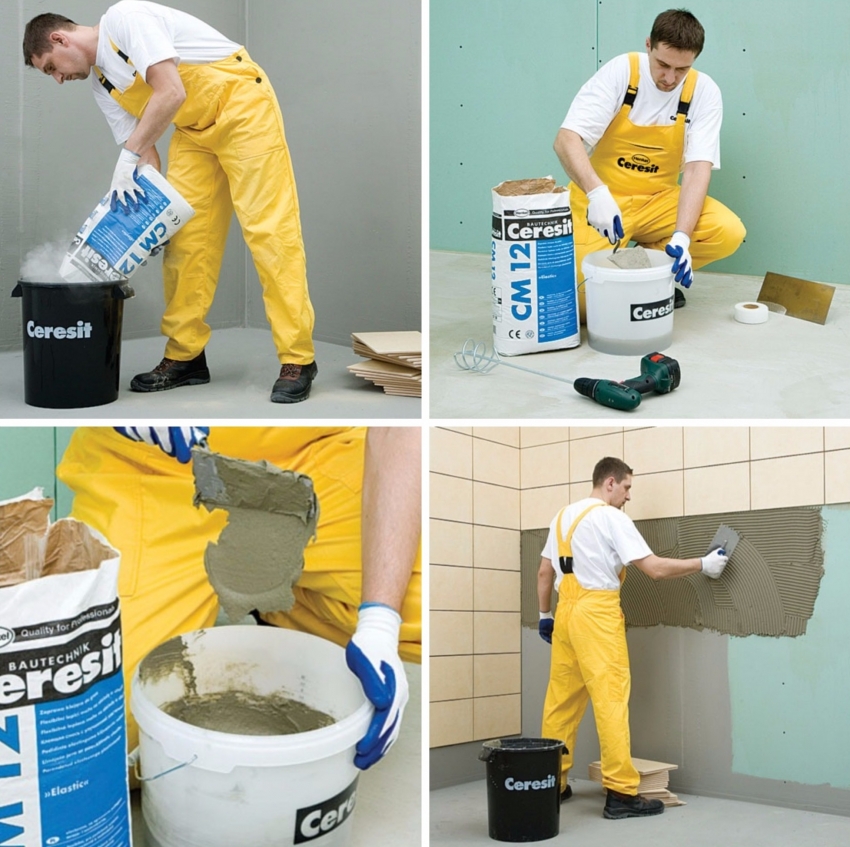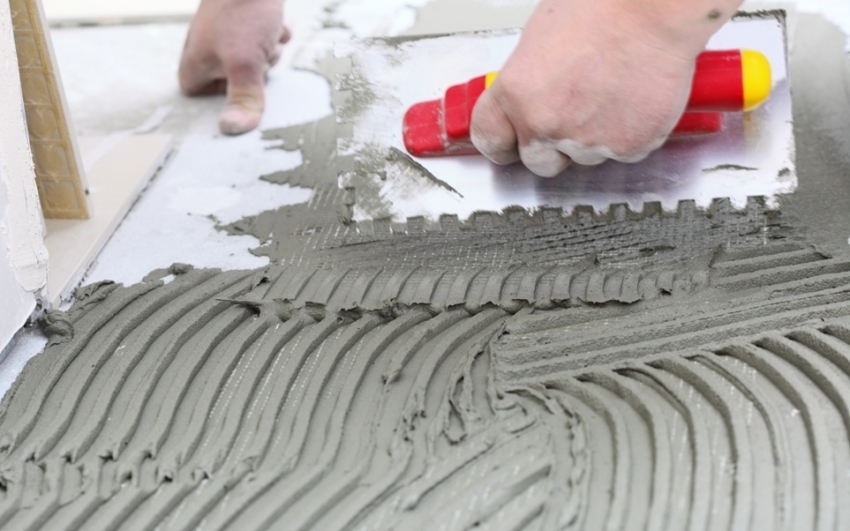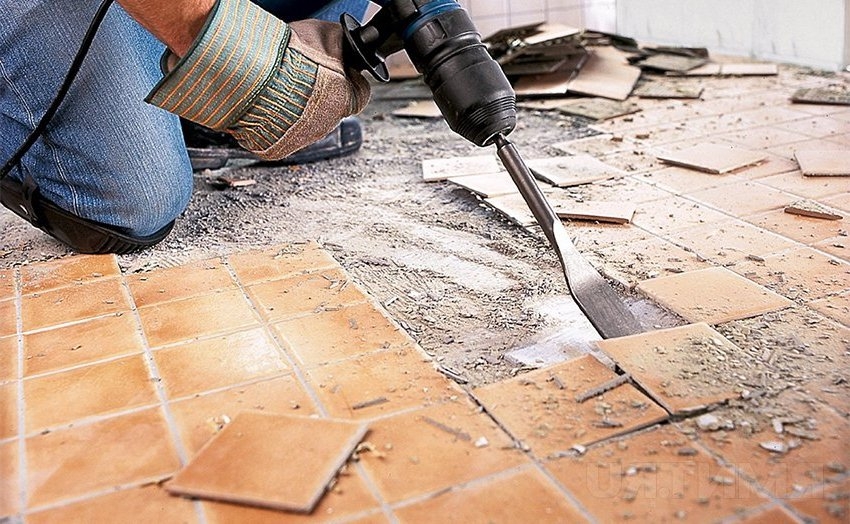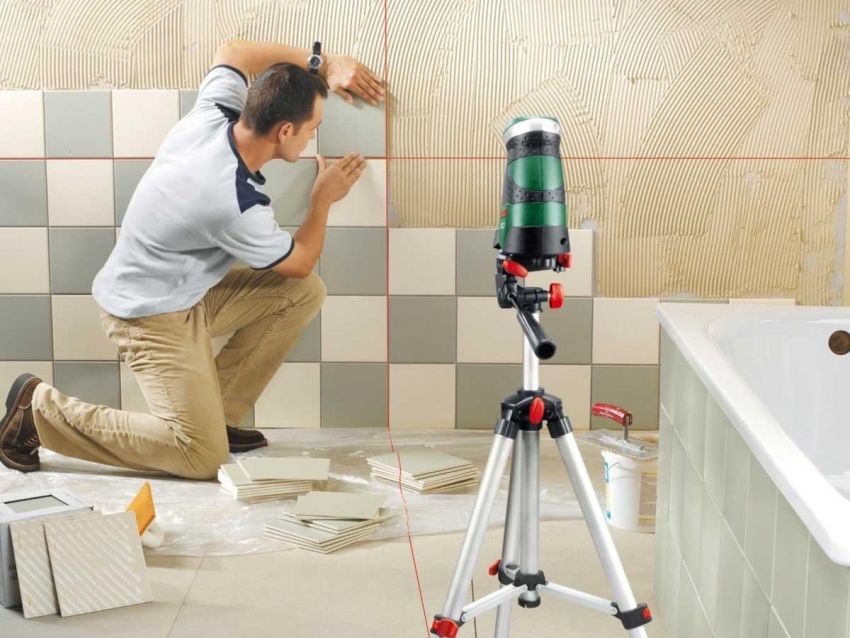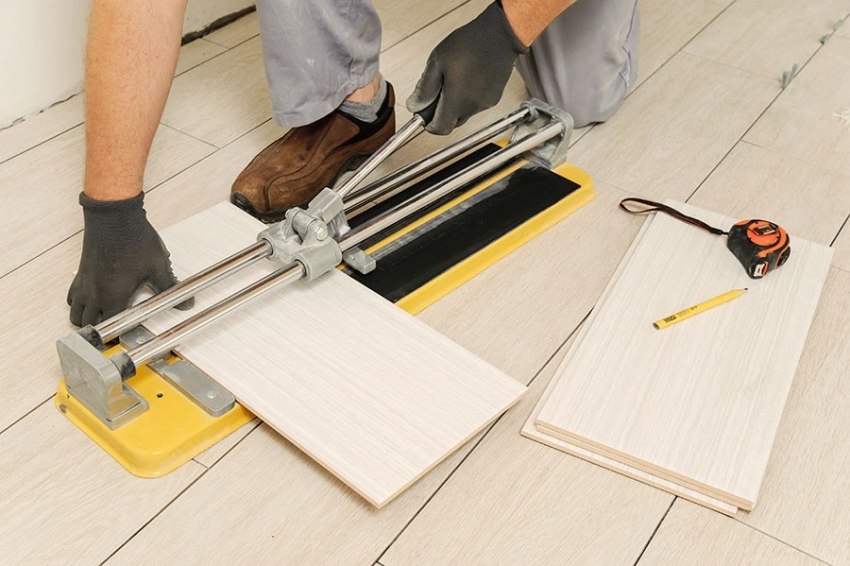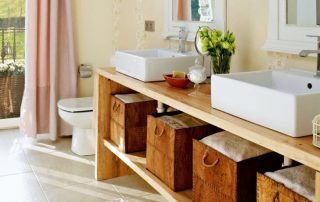Tile is the undisputed leader when it comes to the need to purchase cladding material for finishing the bathroom. It is ideal for both walls and floors, providing the surface with the characteristics required for tough operating conditions. Consider how to lay tiles in the bathroom: how to properly prepare the surface and lay the material.
Content [Hide]
- 1 Advantages and Disadvantages of Tiling the Bathroom
- 2 How to lay tiles in the bathroom: popular installation methods
- 3 How to put tiles in the bathroom: solution preparation technology
- 4 How to lay tiles in the bathroom: preparatory work
- 5 How to lay tiles: the nuances of self-laying
- 6 How to put tiles on walls and floors: how to cut tiles
- 7 How to grind the seams of tiles in the bathroom: video instruction
Advantages and Disadvantages of Tiling the Bathroom
The advantages of using tiles as floor and wall covering for the bathroom include the following characteristics of this material:
- resistance to water and steam;
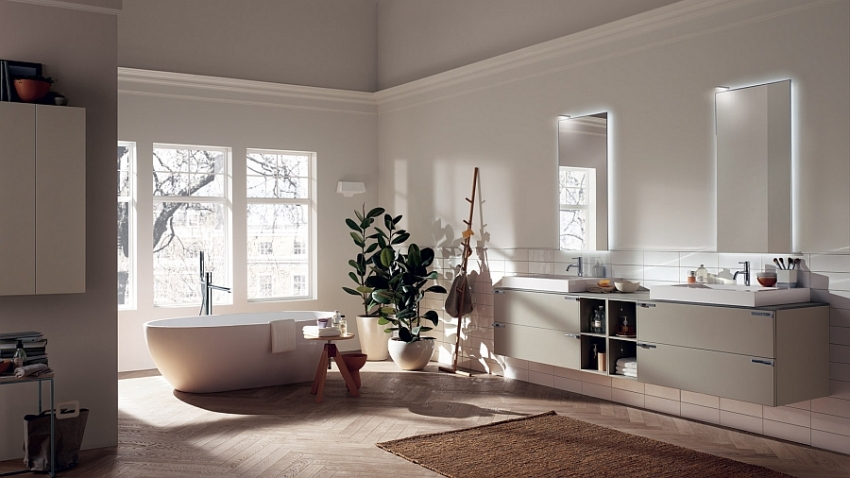
Tile laying carried out in accordance with the rules and recommendations can not only decorate the interior, but also serve for many years
- high strength of the material to mechanical stress;
- relatively simple installation procedure, accessible even for a beginner;
- aesthetic appearance of the surface;
- hygiene and ease of care.
If we compare ceramic tiles with other materials that are used for decorating bathrooms, then there is practically no option that could surpass it in terms of characteristics.
Although it is worth noting that this solution also has some drawbacks, for example, installation of tiles will be quite expensive, given the cost of the tiles themselves, as well as auxiliary materials. And before putting the tiles in the bathroom on the floor or walls, you will have to pay attention to surface preparation.
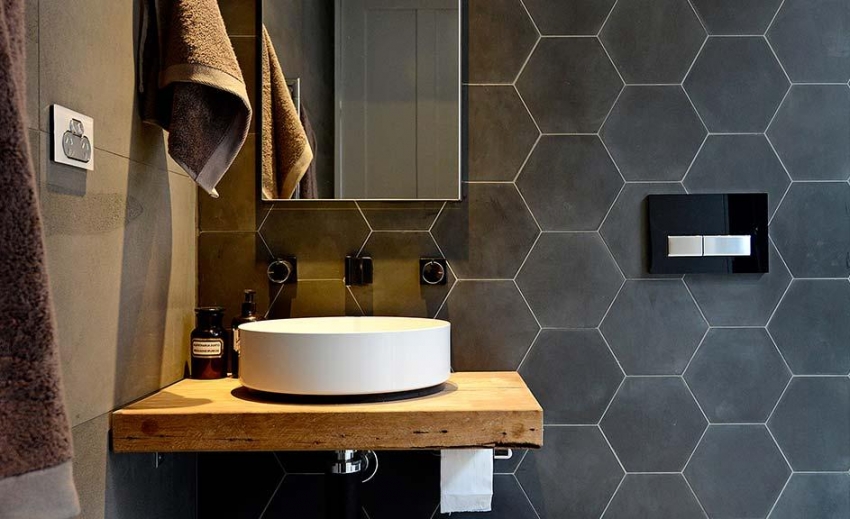
Due to their high performance characteristics, ceramic tiles are the best solution for decorating walls and floors in a bathroom.
How to properly lay tiles in the bathroom: the necessary tools and materials
In order to properly lay the tile on the surface, it is necessary to take care of the availability of certain tools and materials in advance. The list of required items consists of the following items:
- ceramic tiles at the rate of: surface area + 10-15%, depending on the chosen installation method. It is highly discouraged to purchase material end-to-end, since part of the tile may be damaged during transportation or during work. In addition, it is useful to leave a few intact tiles in case the cladding needs to be repaired in the future;
- a suitable adhesive composition, which is designed for this type of work and is able to cope with the upcoming loads;
- grout for joints a suitable color (usually chosen in one tone with a coating or a little lighter);
- a large container in which it will be convenient to knead glue;
- smooth and notched spatulas, with which it will be possible to apply and distribute the adhesive composition over the surface of the tile;
- tile cutter or grinder for cutting individual elements that do not fit in size;
- foam sponge or rags to clean the surface from excess glue;
- special crosses designed to form seams of the same size.
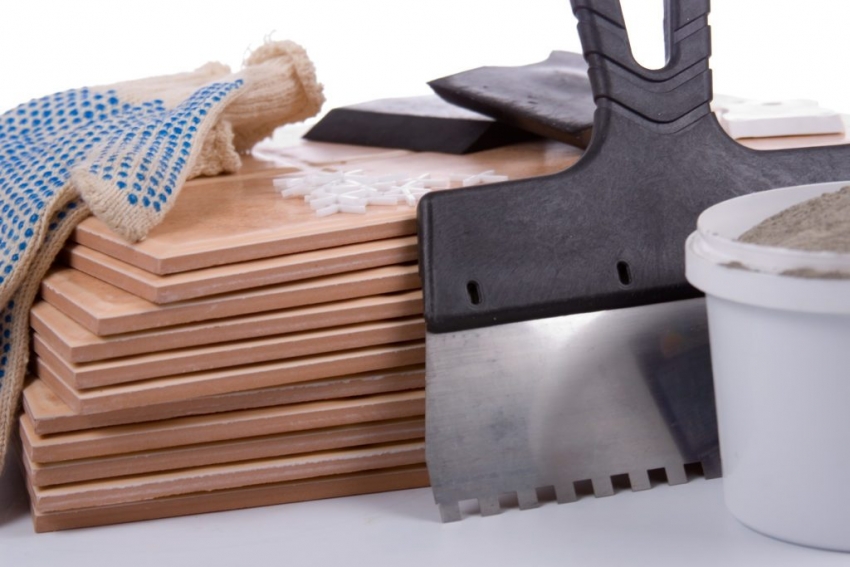
When laying ceramic tiles, do not neglect the recommendations of a specialist on the choice of tools for work
How to lay tiles in the bathroom: popular installation methods
Before proceeding with the selection and purchase of the required amount of material, it is necessary to decide what way the tiles will be laid. Tiling in the bathroom can be done in several ways. At the same time, experts recommend choosing an option that will contribute to the visual expansion of the space.
Consider a few of the most popular examples:
- Direct layout. The simplest and therefore widely used method that can be used even by a completely unprepared person who does not have any experience in this field.
- Diagonal layout. An aesthetic and sometimes more complex option. It is believed that this method is ideal for rooms with a square shape, as well as if the walls are severely uneven. An inexperienced master may have certain difficulties in the process of work, but if we are talking about repairing a small bathroom, then there is simply no better way to find it. Moreover, you can always practice the layout without applying glue.
- Chess pattern. This method is suitable for laying tiles of several colors. As with diagonal installation, this method is recommended for small square rooms. The main advantage of this method is that it is ideally combined with both classic and any modern interior.
- Offset laying. In this case, each next row of tiles is laid with an offset relative to the previous one. At the same time, the joints do not join, which makes the design of the room unique. Unlike previous methods, this option is more suitable for rectangular rooms. This applies to both the wall covering and the tiling in the bathroom.
You can decide how to lay tiles in the bathroom by looking at photo examples or at least a schematic arrangement of tiles in each way. But do not forget that for the implementation of each method, the tile must be correctly selected. For example, for diagonal styling, only square-shaped elements are suitable, and for stacking with an offset, it is better to take rectangular tiles.
Interesting! The question often arises of how to speak correctly, "lay" or "lay down" tiles on the floor or walls. The second option is vernacular, which is permissible, although not considered correct, from the point of view of the literary language.
How to put tiles in the bathroom: solution preparation technology
Obviously, the process of choosing the right tile and how to install it will take time and attention.But many do not even suspect that the selection and mixing of the adhesive composition is no less important task. Let's consider what is worth paying attention to, and whether there is a difference which solution will be used in the process of work.
Tile adhesive can be purchased in one of two types: dry mix or ready-made solution, which only remains to be applied to the surface. In principle, it is permissible to use either option, although the ready-made mixture is usually used only for working on small surfaces. In addition, it does not tolerate storage well. So if you just have to lay the tiles in the bathroom, it is better to purchase a dry mix.
The choice of adhesives for tiles in the modern market is quite large. They can differ in cost, quality and, in some cases, cooking technology. So the first thing to do before diluting the purchased mixture with water is to carefully read the instructions provided by the manufacturer. But you should also take into account the following recommendations:
- kneading the glue should be done only when all surface preparation work is completed;
- when adding water to the mixture, it is necessary to focus on the manufacturer's recommendations, as well as on your own feelings, avoiding excessive fluidity or density of the solution;
- the adhesive composition obtained in the toga must be homogeneous;
- for mixing, it is best to use a hammer drill with a special attachment, since doing everything necessary by hand can be difficult.
Useful advice! Before laying the tiles, you need to make sure that the adhesive will adhere to the surface to be laid on.
How to lay tiles in the bathroom: preparatory work
Before you start laying tiles on the surface, it is necessary to carry out some preparatory procedures that will make the surface as susceptible to the adhesive as possible and ensure reliable fixation of the elements. So, you need to clean the room of all unnecessary pieces of furniture and elements that may interfere with the work. And before gluing the tiles on the walls and floor, if possible, plumbing is also dismantled.
If there is old facing material on the walls, it must be dismantled, and then the surface must be thoroughly cleaned from dust and dirt. Laying option is also possible tiles on tiles... Then you need to measure the area of the room.
Important! If wooden elements were used to lay out the walls, at the preparatory stage it is imperative to open them with an antiseptic to prevent decay processes. Then a layer of plaster is applied on top.
How to dismantle bathroom tiles with your own hands
In most cases, you have to deal with the presence of old tiles on the surface, if we are not talking about repairs in a new building. And in this case, you will have to eliminate it before proceeding with the installation of new tiles. Let's take a closer look at each stage of this process.
First of all, with the help of a hammer drill, which is adjusted to the impact mode, the old tile covering is removed. This process, of course, is dusty and unpleasant, but given the small area of the room, you can do everything you need pretty quickly.
Important!It is imperative to use protective clothing and goggles when removing the old coating, as small particles of tiles can fly off and cause serious injury.
If we are talking about the need to remove paint from the surface, then for this it is best to use solvent compositions and special tools that facilitate its mechanical removal.
After the coating is dismantled, all that remains is to clean it, removing all residues from the surface and thoroughly cleaning the base. At the same stage, it is worth assessing the level of the surface and taking the necessary leveling measures.
How to align the walls in the bathroom: instructions and recommendations
Immediately after the surface of the floor or walls has been cleaned, an assessment must be made to determine if there is a need for leveling.
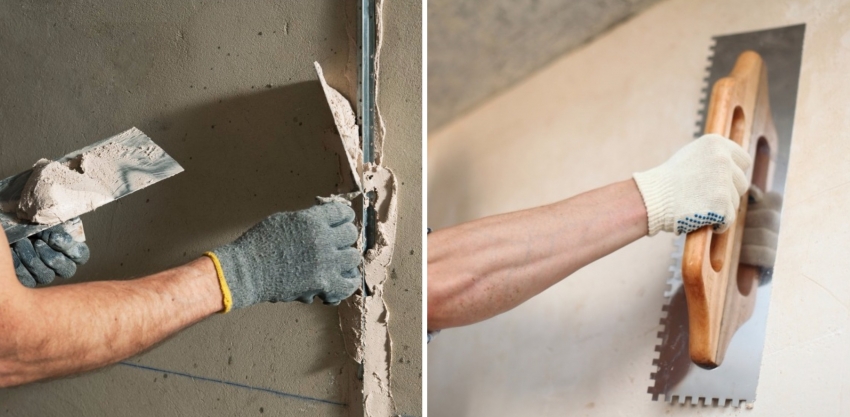
To level the concrete surface of the wall, it is necessary to install beacons and apply an even layer of plaster
A perfectly flat surface is not a prerequisite for a tile, but when it comes to serious deviations, it is better to eliminate them in advance in order to avoid possible problems in the future. Regardless of how the walls in the bathroom are aligned under the tiles, the sequence of actions is as follows:
- A layer of primer is applied to the surface.
- Beacons are placed using the level.
- A layer of plaster is laid, which is distributed between the beacons.
This method is used to level the walls. When working with a floor surface, the procedure is even simpler, and involves the use of a self-leveling mixture that can solve existing problems, and is also easy to prepare and dries quickly.
Related article:
Bathroom tiles: design, photos and recommendations for choosing
Photos of interesting room ideas. Advantages and disadvantages of using bathroom tiles. Tile laying recommendations.
Waterproofing a bathroom under tiles: which material is better
Providing high-quality waterproofing of the bathroom floor under the tiles and even on the walls is another important task. There are many ways and materials for this. Consider some types and their advantages over others:
- bitumen-polymer composition is a plastic mass, which is characterized by high resistance to temperature extremes, as well as to the effects of chemically active substances. The material is applied in a thin layer before proceeding with the laying of the tiles. The composition does not have a pungent odor and is completely safe for human health;
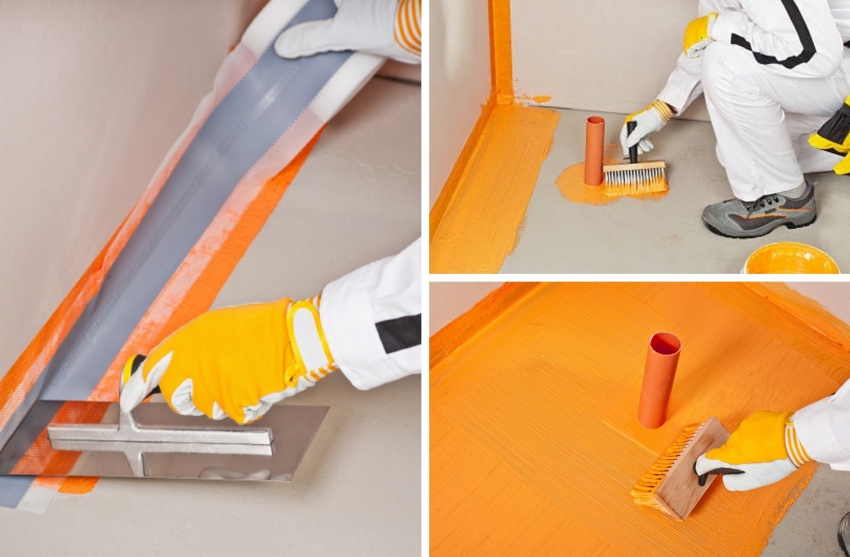
High quality bathroom waterproofing before finishing work will help not only to avoid the growth of fungi and mold, but also to prevent flooding of neighbors in case of water breakthrough
- bitumen-latex waterproofing is a liquid composition that is very popular. Among the positive aspects of using this option are the solidity of the layer, the absence of seams and joints;
- a cement-polymer mixture is one of the best options for waterproofing walls and bathroom floors. The composition is applied with a paint brush on a previously primed and prepared surface;
- acrylic enamel is a budget solution to the problem of waterproofing in the bathroom. The resulting coating is quite capable of coping with its main task for some time, but over time it is prone to cracking, so if you can give preference to another, more reliable option, it is better to do it right away.
In some cases, roll waterproofing is also used, which is made of polyester and fiberglass fabric. In this case, the reverse side of the material is covered with a special adhesive, and the upper side is treated with a substance that promotes adhesion and allows better fixing of the tile with glue. In addition, this option does not require additional drying time and has a very affordable cost.

Waterproofing rolls made of polyester and fiberglass fabric are often used for finishing large rooms
Thus, it is impossible to say unequivocally that it is better to waterproof the bathroom under the tiles with roll materials or with the help of special compounds. Everyone, choose the option that suits you, based on its cost and characteristics.
Important! Before laying rolled waterproofing material, you need to pay attention to how even the surface is. The differences are permissible, but they should not exceed 2 mm.
How to properly lay tiles on walls and floors: where to start
When wondering how to lay the tiles in the bathroom with their own hands, many want to understand where is the best place to start. After all, this is what determines how to glue the tiles in the bathroom and how comfortable this process will be.
First of all, it is worth noting that you need to start laying the tiles from the walls. If possible, the floor should always be done last so as not to stain or damage the coating.
With rare exceptions, the laying of tiles on the walls starts from the bottom up, but with the floor covering, the situation is somewhat more complicated. You can lay tiles on the floor starting from several places:
- from the far visible corner;
- from the threshold;
- from the center of the room.
Which of the options will be chosen depends on the wishes of the master, and in some cases also on the method of laying, since in some cases it is more convenient to start laying from the center in order to lay out the drawing or correctly place the patterns.
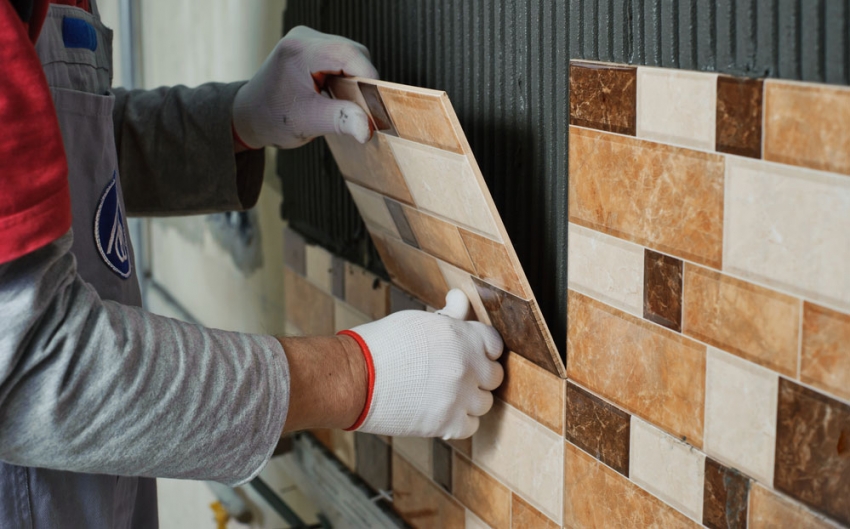
The quality of the adhesive determines the durability of the tile covering, therefore it is best to prepare the mixture immediately before laying.
How to lay tiles: the nuances of self-laying
In order to understand how to lay out the tiles in the bathroom, you need to pay attention to the algorithm of the work, as well as to the features and nuances. Consider the most difficult and interesting aspects of this process that can cause difficulties for an inexperienced master:
- Dry laying tiles on the surface is the best way to practice laying out the pattern and make sure that the material is cut and laid out properly;
- to facilitate the installation process, markings must be applied to the surface. This will significantly reduce the likelihood of making a mistake and will not be distracted from the styling;
- if laying is done on a concrete base, then it is best to work gradually and with small areas;
- each laid section of tiles must be checked for evenness using a building level. You can adjust the height of the location of individual elements by adding or removing an adhesive composition;
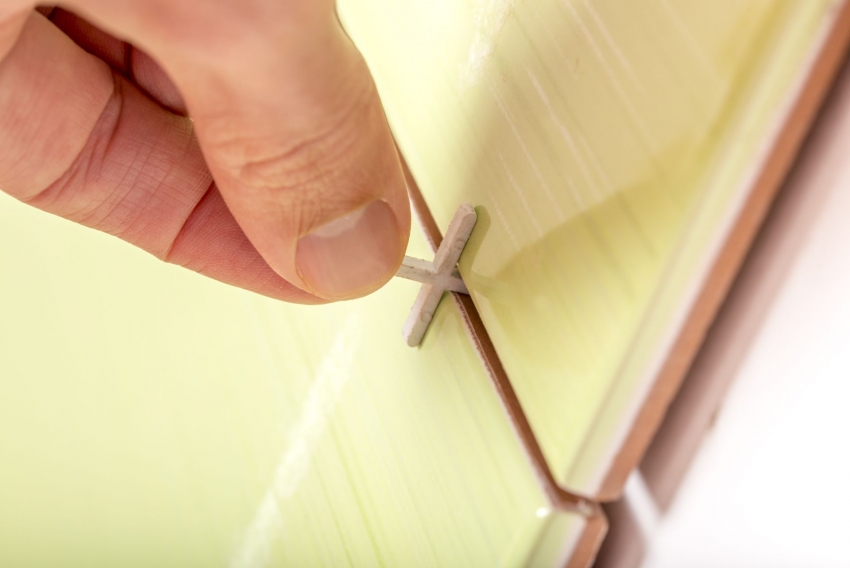
When working with tiles, it is necessary to use special crosses that will help control the width of the joints and the height of the laying of each element.
- it is imperative to use special crosses, since only they are able to provide a truly equal distance between the elements and make the seams as aesthetic as possible;
- glue is usually applied directly to walls and floors, as this ensures that the laid out material will hold tightly and for a long time;
- if installation on walls is carried out, then a special glue is selected, characterized by fast setting;
- protruding glue is quickly removed with a plastic spatula;
- if you have to lay tiles in the bathroom in hard-to-reach and difficult areas, for example, bending around the toilet, then it is cut off with a tile cutter or other suitable tool;
- after creating the coating, the threshold is set in the bathroom.
Thus, it is quite easy to install bathroom tiles on the floor or walls. Moreover, adhering to the technology, you can cope with the task quite quickly, having mounted a beautiful and reliable coating as a result.
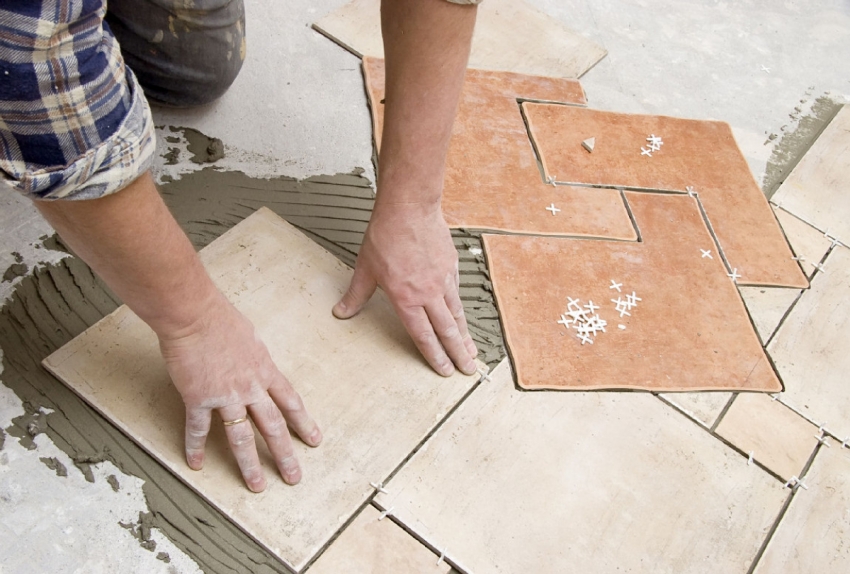
When decorating a large bathroom, glue is applied to small areas and gradually filled with a tile covering
How to put tiles on walls and floors: how to cut tiles
Having made the decision to independently install the tiles, you will have to familiarize yourself with the methods of cutting it, since situations when the tile is ideally sized and lays down without fitting are extremely rare. The most common tools that are used for this purpose are:
- electric tile cutter - a quick and easy way to make a quality cut. The tool is designed in such a way that water gets into the place that is prone to cutting. This improves the quality of the resulting elements;
- a manual tile cutter is the most popular option as it is much easier and cheaper to purchase than any other. In order to cut off part of the element, the appropriate marking is made on the tile, after which, using a tile cutter and physical effort, the unnecessary part is cut off;
- a roller glass cutter is not a very popular option, which, nevertheless, can sometimes be found. This tool is much more suitable for working with gypsum tiles, but often simply cannot cope with ceramics;
- a grinder is another way to cut tiles. The advantage of this option is accessibility, but the disadvantage is not too even and clean cut.
Of course, when choosing a way to cut tiles, you have to build on the tools and capabilities available. It is far from always possible to purchase a special tool, but it is important to understand that in some cases it is better to spend additional funds in advance than to get unaesthetic coverage in the future, which will be problematic from a financial point of view.
How to grind the seams of tiles in the bathroom: video instruction
The quality of the grout largely determines the beauty, as well as the life of the coating, since it affects how resistant the tile will be to water and steam. Therefore, the issue of choosing and applying grout should be given special attention, choosing the most suitable color, and applying the composition with high quality.
Grout is applied using a rubber spatula in such a way as to fill all voids and crevices as thoroughly as possible. Immediately after this, all surpluses must be removed in order to avoid drying out on the surface of the tile. The installation of the threshold and other similar elements is carried out only after the composition is completely dry.
Important!The consumption of grout for tile joints per 1 m2 can vary quite a lot depending on the manufacturer and can range from 0.25 kg to 0.5 kg.
How to lay tiles in the bathroom: video instructions for work
Taking into account the considerable cost of tile laying work, it is worth considering the possibility of doing the work yourself. This option allows you not only to save money, but also independently implement any ideas for decorating a bathroom. In this case, the tile is an ideal option, since it has the proper strength and at the same time has a large number of color and texture solutions.
